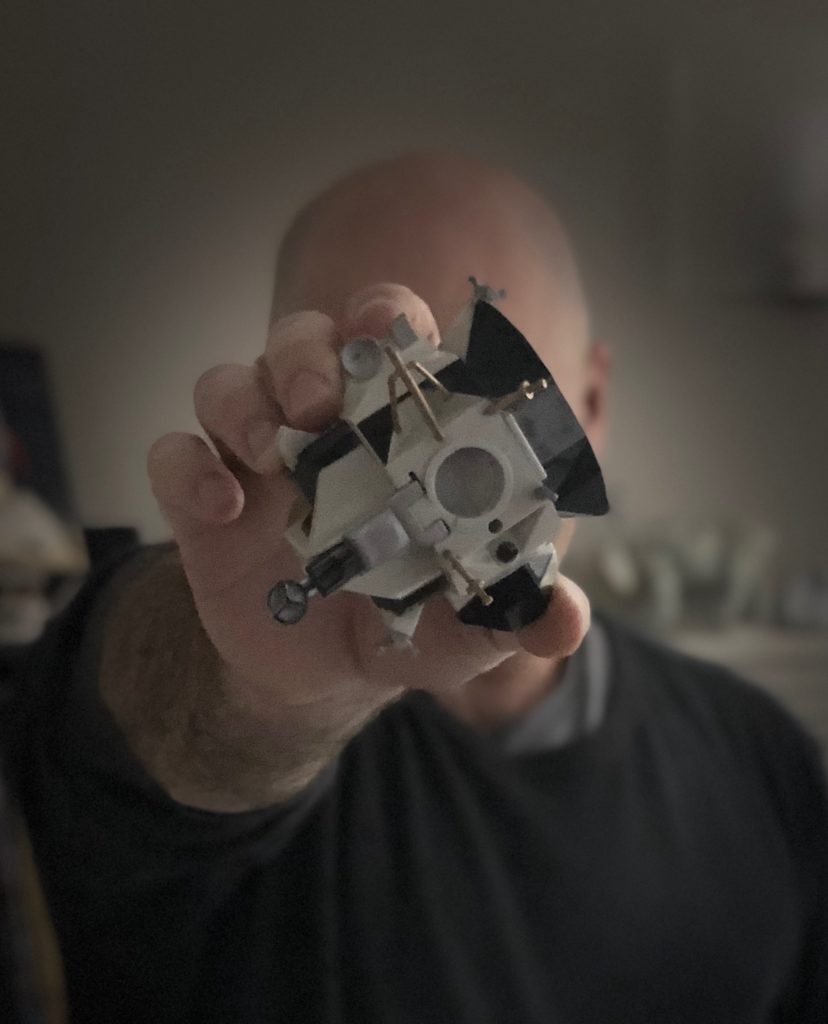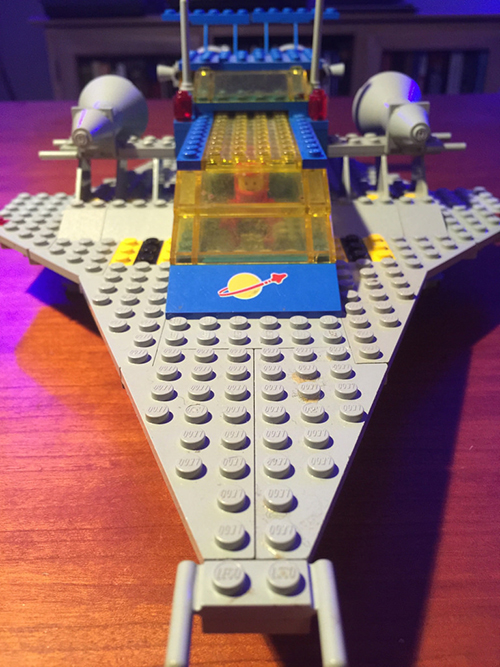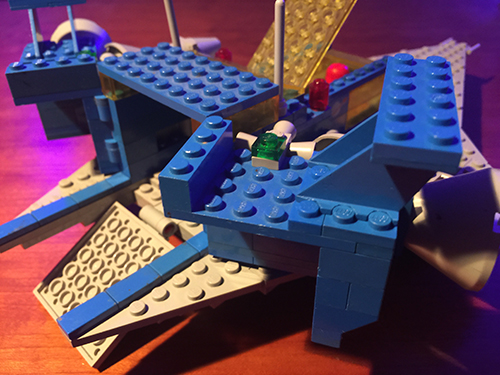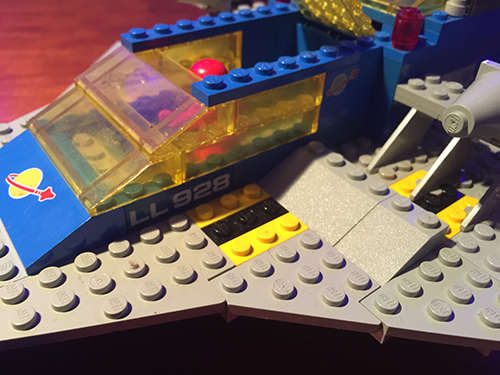Spaceship! Spaceship! Spaceship!
A few notes on rebuilding my first LEGO set from 1979.
I set out to build the iconic, genre-defining LEGO Galaxy Explorer. I knew I had the original pieces as I have every brick I was ever given, bought, or bought for my own kids. There are tens of thousands of pieces in several bins full of 35 years of detritus that inadvertantly got mixed into the slurry. Batteries from the 1980’s (long since having leaked their acid), various mementos, trash, thumbtacks, model pieces, indecipherable bits of toys and games, sharp shards of pieces long since stepped-on and cracked. Finding the original bricks was part autobiographical archaeology, part that Russian Roulette scene with the log creature in Flash Gordon.
The LEGO Galaxy Explorer jumpstarted the “Classic” phase of space-themed brick sets. Before dueling factions, before space police, before aliens and whatever the hell Bionicle was, Classic Space was about exploration, period. It’s interesting to read the set as a kind of cultural document for the vision (perhaps a Danish vision) of what spaceflight was or could be in the late 70’s.
Apollo was over. Skylab had just plummeted back to Earth. Salyut 6 still orbited. And the Space Shuttle was in testing for its maiden voyage. Clearly the shuttle was an influence on the Galaxy Explorer: both have fixed wings and separate crew and cargo compartments. But exploring the design of the brick ship suggests that the new NASA orbiter was not its only inspiration.
The Galaxy Explorer is the threesome lovechild of a Space Shuttle, a dump truck and a Harrier jet. How else would you explain the loading ramp in the back which really only works in gravity where you can cart things up? Or that, without wheels, the ship clearly does not take off like a plane. The underside engines are obviously for vertical ascent. And if you got those, why do you need wings at all?
The answer is what makes LEGO such an incredible company: the design of the ship is as influenced by how human beings play with interlocking bricks as it is by actual spaceships. It’s the difference between LEGO and model kits. For one, kids play with LEGO bricks in an environment with gravity. They might fly the ship in their hand through the air, but actually interacting with it takes place on some surface, orbital mechanics be damned. This explains the loading ramp (kid drives LEGO car around on a surface and into the ship) and the vertical take off (kid grabs the ship and yanks it up), and even the wings (that’s how the kid holds it). It’s a very planet-based (or at least surface-based) view of space travel, because that’s how (and where) kids play.
Play as primary design driver is evident in an odd little locking piece that keeps the cargo bay doors from flying open. It is one of the rare instances I know of where a piece is added simply for convenience of real-world usage. The 1×2 flat blue piece has no aesthetic or functional value on the ship-as-ship, only for ship-as-plaything. Take that, fourth wall!

Then there’s the ornamental, gaudy and inexplicable: racing stripes (huh?), logos, vents, fuselage arrows (for ground crews?) and livery numbers. No decals, thankfully. The whole thing was driven by an actual circular steering wheel (something even airplanes don’t use). Maybe the ship never did leave the ground: the minifigs have visor-less helmets and zero protection from the (lack of) elements other than their spacesuits.
It’s the color scheme, though, that defines Classic Space for me. Gray base plates and horizontal surfaces, blue structural elements, translucent yellow windows. Toss in a few computer bricks (oh, the computer brick!), a radar dish, and some green and red see-through 1×3 cylinders — that aesthetic shaped my LEGO creations for the better part of a decade. (Green? There is no green in space.)
But there is yellow. As in yellowing pieces. Though I was fastidious in making sure I found ever single correct piece — never substituting or otherwise being clever — I obviously did not find all the original pieces. The slight yellowing (and relative state of cruft accumulation) on some of the bricks is a dead giveaway. I bet 30% of the ship is original. I kinda like it actually. The original Star Wars showed us how cool beaten-up, dusty and old space could be. My LEGO Galaxy Explorer wears the patina of time well.
If you’ve seen The LEGO Movie you have witnessed the legacy of the Explorer. The character Benny maniacally flies around yelling “Spaceship! Spaceship! Spaceship!” in a craft that is clearly inspired by the original set. It’s over-the-top, but retains the rough geometry, retro rockets, racing strips, and (maybe) the cargo bay. In a nod to dorks like me in the film, the actual spacesuited character is cracked and clearly worn through time.
Sometimes the future is nostalgia.
Lost in Space, Ascent Stage edition
Got the urge to muck with the Lost in Space theme recently. I loved the re-runs of that show growing up (and have deliberately forgotten that a movie was made of it in the 90’s). The theme I used began with the show’s third season.
The title track is tiny, just one minute long with an unfortunate or awesome (your pick) Austin Powers breakdown in the middle, so there wasn’t much to work with. The arpeggios are emblematically spacey to me so I ran with that. I replaced The Robot with Siri, the panicky AI of our time (especially when using Apple Maps).
I really should embed this on this site’s 404 page.
Geeks with a project
If you spend any time on the web you know that today is the 40th anniversary of Apollo 11’s moon landing and the first steps of humans on the lunar surface. There’s been some great coverage from We Choose The Moon, to the live Twitter feed “replay”, to Kottke’s (now-finished) real-time TV coverage playback, to the Google graphic that actually has changed to follow the progression of the landing (and earthrise)!
The commemoration has caused me to reflect personally on the impact of the moon landing. Despite what you may have heard, the name of this blog references the upper half of the lunar lander, the stage that ascends to rendezvous with the command module for the journey home. My choice of that term came from a period of my life of intense interest in spaceflight* partially because of the sheer thrill of it, partially because of the series From The Earth To The Moon, but mostly because, at the time, I was a young project manager in a massive organization who saw in the moonshots the attempt to do something amazing with lots of smart people, cutting-edge technology, and a common goal. I didn’t want to be Neil Armstrong so much as Gene Kranz.
In the tributes, you’re not hearing a lot about the thousands of private contractors who helped plop the 12 guys on the moon. But the organization of that many people to do something of that magnitude in just a little more than 7 years may be as remarkable as the outcome.
IBM, the company that I work for, was a large part of this effort and I admit that this is a source of pride for me. I’ve had this photo of mission control taped to my cube for as long as I can remember.
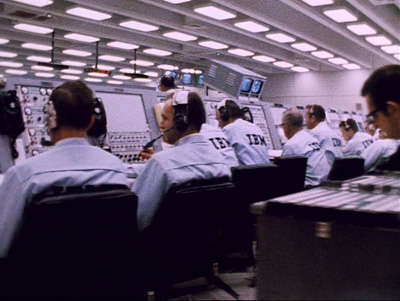
These are my people. Practitioners of a timeless nerdiness that I think of often when I confront organizational bureaucracy or technical hurdles in my own job — one which ain’t, after all, rocket science. IBM has a great subsite up on our contribution to the space race.
Closer to home, I have the memory of my wife’s grandfather, William Boulet, who went to work as an engineer for Boeing after leaving the Army Air Corps after WWII (where he survived a year as a Nazi prisoner). At Boeing Grandpa Boulet designed a particular bolt that was used inside the fuselage of the Saturn V rocket and for his service he was given a commemorative medal — a keepsake I was given by his family when he passed away in 2005. I grabbed it before I left for work today. Not exactly sure why, but I felt like having it with me.
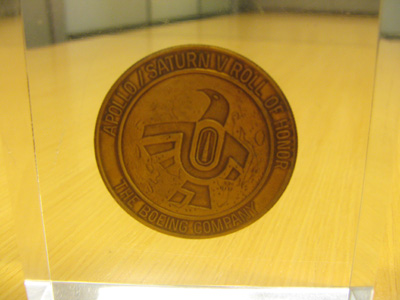
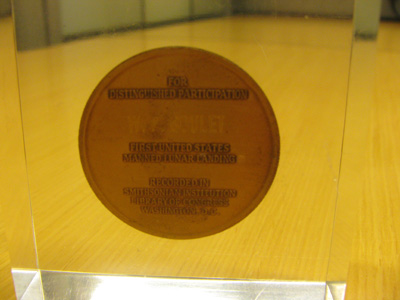
It isn’t nostalgia, of course, for I was not alive for any but the very last landing — and only a newborn then. For me, the Apollo program is equal parts inspirational and aspirational. Whether you agree with the purely political motives that set us on the course to the moon or not, my feeling is that what the effort itself represents is the very best of what humans can do when given a massive challenge packaged in a disheveled box of constraint.
We certainly have freighters full of that particular parcel today. Let’s get unwrapping.
* An interest, it should be noted, that has not so much waned as been tempered by the seeming lack of grand purpose that NASA has fallen into as an orbital trucking company.
Space opera
Lots of things happening heavenward today.
An astronaut whose mother was killed by a train while he was on the International Space Station for 120 days will return to Earth on the Shuttle.
The US Navy will attempt to hit a satellite moving at 22,783 MPH with a warhead-less missile launched from a ship in the Pacific. (Note to military: ever considered a self-destruct button on our spy sats? Or just telling the world we’re testing a new weapons plaftorm? That would work too.)
A total lunar eclipse will occur at 10:01 PM ET tonight.
All of you on the good Earth
Apollo 8: December 24, 1968
A game that would displease the range safety officer
OK, so here’s an inspired idea, the kind of thing devised by idiots who’ve been drinking all weekend.

You know the game called 500? Basically you throw a tennis ball into the air. Players then run under it, pushing, shoving, and perhaps groping for the ball as it comes down. You get 100 points for catching it on the fly, 75 for one bounce, 50 for two, etc. If you touch it on the fly and drop it you lose 100 points, with negative points for touching the ball mirroring the gains for catching it. (At least that’s how I grew up playing it.)
So this weekend. My college friends and I were gathered for our annual Fall session of telling stories like none of us had ever heard them before and being demonstratively juvenile. We discovered that the house we were staying in contained a model rocket and loads of propellant. Of course we had to shoot it off.
I had not done this since I was little. I was soon reminded that the key to the whole thing (or rather the key to doing it more than once) is the secondary charge that goes off to spring the nose cone and deploy the parachute which floats the whole fuselage* back to Earth.
We were doing in this in the middle of a prairie. It wasn’t exactly parched, but I’m not sure Smokey the Bear (or NASA or the FAA) would have approved. As soon as the first one went up a small group of the inebriated ran out into the field, matching — or attempting to match — the trajectory of the descent with their own jagged strides. Just like 500, you see. But the problem was that it was dusk and the rocket went way the hell up. At it’s apogee (yay, SAT!) it was lost from human eyesight. Only a few hundred yards up did it become visible and usually it was hurtling down with a half-opened, if not outright flaming, parachute. Dangerous as all hell. If you’re not pegged in the face with a rocket strut you’re scalded by the hot cylinder itself. It was pure comedy.
Try it sometime and remember where the game was invented, right here on Ascent Stage. For added difficulty play in an urban area with lots of obstacles.
[*] A descent stage, you might say. But you would be wrong. A descent stage is a powered rocket whose purpose is to counteract gravity during a descent (as in to the moon). But that’s a great idea. Where are the model rockets with descent stages!?
Project wisdom from the old NASA
“If a major project is truly innovative, you cannot possibly know its exact cost and its exact schedule at the beginning. And if in fact you do know the exact cost and the exact schedule, chances are that the technology is obsolete.”
— Joseph G. Gavin, Jr., discussing the design of the lunar module* that landed NASA astronauts on the moon.
Yeah, boss. That’s why we’re late and over budget. You don’t want to be obsolete, do you?
[*] The upper half of which is called, ahem, an ascent stage. We’re all about inspirations to innovation around here.
Via SvN.
Caputo’s career kaput
Looks like my shout-out last year to the world’s first female Italian-American in orbit will be my last for her. The press just loves the story of Lisa Caputo Nowak’s alleged melting-down over a love triangle — as though astronauts aren’t human. She’s an Italiana, fercrissakes! Of course she’s fiery!
I think it’s fair to say that she’s not going to pass the next pre-flight psych check. My guess.
If you’re catty in space, can anyone hear you growl?
UPDATE: And the whole fascination with wearing diapers for the long drive. C’mon, how do you think they spacewalk for 8 hours? She’s just used to efficiency.
Taikographs
My pal Victor in Beijing presented me with this set of signed commemorative postcards from China’s first two manned spaceflights. The outer envelope, pictured here, contains the signatures of Yang Liwei, China’s first man in space, and Fei Junlong and Nie Haisheng, the occupants of the second ship up. Inside are three separate cards corresponding to the individual taikonauts, also signed.
Victor got the autographs because he works closely with accessibility organizations in China and so he knows the head of the China Disabled Persons’ Federation, Deng Pufang, the son of Deng Xiaoping. With a dad like that Deng Pufang of course has friends in high places and thus were Victor and the spacemen at the same reception. Deng Pufang, by the way, became a paraplegic during the Cultural Revolution as the result of falling from a fourth floor window to escape torture.

